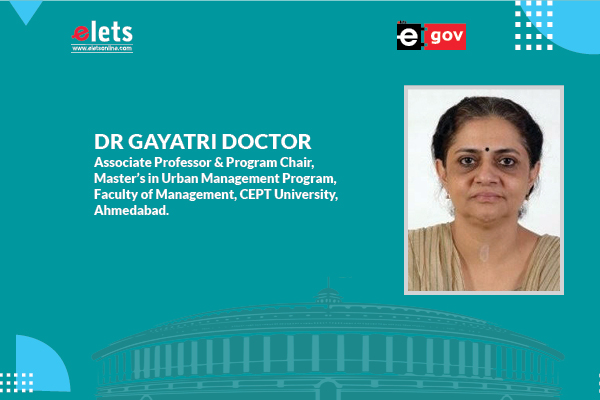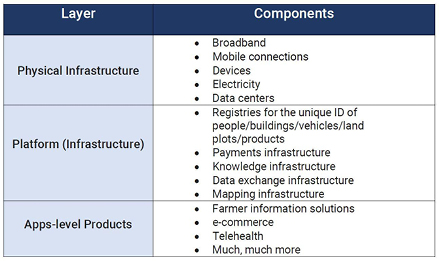
Post 2000 and the dotcom bubble burst, technology has drastically changed our daily lives and society, with the advent of smart phones and usage of social media. Technology has changed not only media, climate action and healthcare but many sectors over the past years. It is a revolution that has not only changed our daily habits but can be used to improve our daily lives and in the future be more sustainable, writes Dr. Gayatri Doctor, Associate Professor & Program Chair, Master’s in Urban Management Program, Faculty of Management, CEPT University, Ahmedabad.
The “2030 Agenda for Sustainable Development” has been adopted in 2015 by all the United Nations Member States. It provides a shared blueprint for peace and prosperity for people and the planet, now and in the future. The Sustainable Development Goals (SDGs) aim to bring together all countries developed and developing, across the globe to tackle some of the world’s most important and critical issues. Along with strategies to improve health and education, there must be a focus on ending poverty, reducing inequality, improving economic growth. Dealing with and tackling climate change and preserving oceans and forests must also be a part of the agenda. The aim is to create a more sustainable future by 2030. The United Nations has identified “Science, Technology, and Innovation” as one of the main “means of implementation” to be able to achieve the SDGs by 2030 (United Nations, 2022).
Post-2000 and the dot-com bubble burst, technology has drastically changed our daily lives and society, with the advent of smartphones and social media. Technology has changed not only media, climate action, and healthcare but many sectors over the past years. It is a revolution that has changed our daily habits and can be used to improve our daily lives and in the future be more sustainable.

Also Read | Using Urban Management to Increase Urban Green Cover – A case of Coimbatore, Tamil Nadu
Many people around the world are already using the internet. Yet much more can be done in this epoch of connectivity, sharing, storage, and increased processing power.
Technology can help reduce inequalities by providing access to services like e-health, e-learning, and more. Using e-tools, the government can connect with the citizens better, improve information management, and stakeholder engagement. One of the important enablers to enhance connectivity and minimize digital isolation is Broadband. Billions of people have access to information and various types of online tools owing to the advent of mobile technology. This allows for insights into populations and their patterns of usage.

The Fourth Industrial Revolution, more commonly known as Industry 4.0, is all about the Internet of Things (IoT). A popular definition of IoT is “the network of physical objects that contain embedded technology to sense and interact with the environment and each other to collect and exchange data to make our lives better”. Data analytics, sensors, and IoT are instrumental in solving some world problems by networking and communicating, as this allows the sharing of valuable information across networks, devices and machines; tracking and monitoring by enabling real-time data capture and reporting about the operational performance of connected systems; analysing, optimising, predicting and deriving insights from the collected data for informed decision making; automating by connecting the digital and physical worlds through the creation of autonomous systems and remote control (Jacobsen, 2018).
New business models which leverage technology are being introduced by governments and businesses, this promotes sustainability and improves the general standard of living. Artificial Intelligence (AI), blockchain technology, machine learning, robotics, 5G, cloud computing, are several other emerging technologies that are being utilised in solutions in an attempt to achieve the SDGs. These technologies are connecting citizens around the world, monitoring, and tracking environmental impact, optimising industrial inefficiencies. They contribute to vast improvements in access to public services, provision of social protection, and new economic opportunities for many people. Thus, traditionally wasteful practices are being transformed into sustainable and efficient means of operation. (Doyle, 2021).
At one level, digital technology is formally included within multiple SDG targets, especially under Goal 9 for infrastructure and innovation. Target SDG 9.1 is to “Develop quality, reliable, sustainable and resilient infrastructure, including regional and transborder infrastructure, to support economic development and human well-being, with a focus on affordable and equitable access for all.” Target 9.c is to “Significantly increase access to information and communications technology and strive to provide universal and affordable access to the internet in the least developed countries by 2020.”
Also Read | Odisha’s Puri Exemplifies Achivement of SDG 6.1
As per International Telecommunication Union (ITU), digital technologies can contribute significantly to the fulfilment of every SDG. To mention a few, by making agricultural practices more data- driven and efficient, ICT-enabled solutions can help farmers reduce their use of energy but increase crop yields, thus contributing to SDG 2 on Zero Hunger. SDG 3, focusing on good health and well-being, can be addressed by directly interacting with patients, health informatics and telemedicine. These services can be improved through better connectivity. New and emerging digital technologies facilitate smart water and sanitation management, and wastewater management catering to SDG 6 on clean water and sanitation. SDG 11 deals with sustainable cities and communities and aims for cities to take key steps to become smart and sustainable. Smart cities are where digital connectivity, data, and citizen knowledge generates opportunities for public services to become better adapted for the citizens. Digital tools allow increasingly sophisticated climate modelling. Green data centres and green power feeding systems are promoted by establishing standards thus SDG 13 addressing climate change action is promoted. Technology can be used to identify, monitor, photograph, and track wildlife populations. Radio Frequency Identification (RFID) chips and sensor networks can be used to protect endangered animals to learn more about their migratory patterns and their needs for protection. This helps achieve SDG 15 which brings to focus life on land (International Telecommunication Union, 2021).

Figure 1: Three Layers of Digital Technology Ecosystem
Digital Public Technologies (DPT) need to be understood in the context of complex digital ecosystems that governments and service providers need to navigate. (Ingram, McArthur, & Vora, 2022). Figure 1 illustrates the foundational role of physical and platform infrastructure in enabling applications and services to thrive across the public and private sectors. These infrastructure layers underpin every retail e-commerce solution, mobile and online banking interface, health and fitness application, e-government service, and much more.
Together they enable a sort of explosion of innovation, in the form of applications that simply cannot be predicted or even limited. When present, pervasive, and designed well, physical and platform infrastructure has the potential for widespread use that serves all social and economic sectors, including those that promote SDG achievement.
As shown in the figure, there are five different DPT platforms which can play an important role in accelerating SDG achievement.
● Personal identification and
registration infrastructure allow citizens and organisations to have equal access to basic rights and services.
● Payment’s infrastructure enables
efficient resource transfer with low transaction costs.
● Knowledge infrastructure links
educational resources and data sets in an open or permissioned format.
● Data exchange infrastructure
enables interoperability of independent databases.
● Mapping infrastructure intersects with data exchange platforms to empower geospatially enabled diagnostics and service delivery opportunities.
All the above-mentioned platform types can contribute directly or indirectly to an array of SDG outcomes. For example, the ability of a person to register their identity is important. SDG 16.9 focuses on legal identity for all including birth registrations; SDG 1.4 is all about equal rights to ownership – control over land and other forms of property; SDG 8.10 is all about access to banking, insurance, and financial services to all.
While DPT platforms offer the potential to help advance many SDG strategies, design and deployment processes often raise considerable challenges. Financial stability is one of the most common operational problems. Limited capabilities to design, deploy and manage a platform, and procurement obstacles within the government are other problems. DPTs can also diminish SDG outcomes, lead to misuse of individuals’ data, and increase the inequalities in digital access.
Also Read | Uttar Pradesh Moving Beyond Basics to Achieve SDG 6
There are three possible ways to harness technology, achieve the SDGs, and create a better world. First, replacement, which is using technologies to replace a manual process, digital signatures against traditional paper signatures or digital payments against paper money. Second, optimisation, which relies on technology to make a process more efficient by way of data or automation, increasing productivity, and reliability. The third is to redesign, which is creating new business models using technologies to reinvent a product or a service.
Multi-user vehicles like Uber, Ola, provide a unique opportunity to reduce resources and contribute to sustainability instead of single user cars or Swiggy and Zomato for food delivery (IE University, 2021)
Digital technologies take on an important role in the attainment of the SDGs by 2030, especially with the deployment of new technologies and innovations. New technologies bring with them unknown opportunities and risks, innovation can affect progress both positively and negatively.
References
● Doyle, M. (2021, June 30). The Role of Sustainable Technologies in Achieving the SDGs. Retrieved from https:// theworldwecreate.net/insights/role-of-sustainable- technologies-in-achieving-sdgs
● IE University. (2021, October 21). How technology support the Sustainable Development Goals. Retrieved from https://drivinginnovation.ie.edu/how-can-technology-support-the- sustainable-development-goals/
● Ingram, G., McArthur, J. W., & Vora, P. (2022, May 25). How can digital public technologies accelerate progress on the Sustainable Development Goals? Retrieved from https://www. brookings.edu/research/how-can-digital-public-technologies- accelerate-progress-on-the-sustainable-development-goals/
● International Telecommunication Union . (2021, December). Digital technologies to achieve the UN SDGs. Retrieved from ITU Committed to Managing the World: https://www.itu.int/en/mediacentre/backgrounders/Pages/icts-to-achieve-the-united- nations-sustainable-development-goals.aspx#:~:text=%20 Digital%20technologies%20can%20contribute%20 significantly%20to%20the,the%20International%20Labour%20 Organization%20%28I
● Jacobsen, B. R. (2018, July 31). Digital technology for the sustainable development goals. Retrieved from https://www. diplomacy.edu/blog/digital-technology-sdgs/
● United Nations. (2022). The 17 Goals – Sustainable Developement. Retrieved from https://sdgs.un.org/goals
Be a part of Elets Collaborative Initiatives. Join Us for Upcoming Events and explore business opportunities. Like us on Facebook , connect with us on LinkedIn and follow us on Twitter, Instagram.











